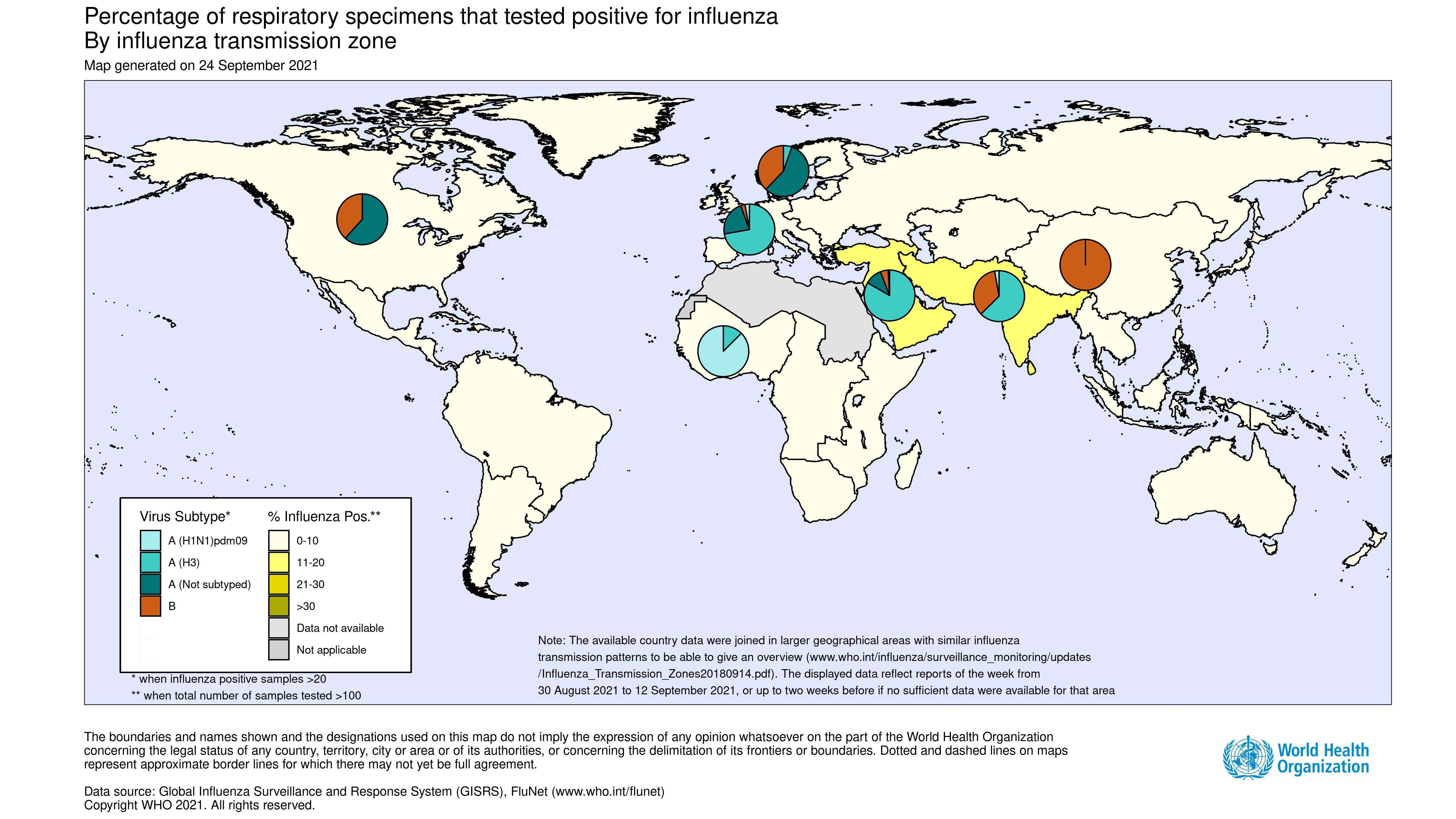Influenza Update N° 403

Overview
27 September 2021, based on data up to 12 September 2021
Information in this report is categorized by influenza transmission zones, which are geographical groups of countries, areas or territories with similar influenza transmission patterns. For more information on influenza transmission zones, see the link below:Influenza Transmission Zones (pdf, 659kb)
- The current influenza surveillance data should be interpreted with caution as the ongoing COVID-19 pandemic has influenced to varying extents health seeking behaviours, staffing/routines in sentinel sites, as well as testing priorities and capacities in Member States. The various hygiene and physical distancing measures implemented by Member States to reduce SARS-CoV-2 virus transmission have likely played a role in reducing influenza virus transmission.
- Globally, despite continued or even increased testing for influenza in some countries, influenza activity remained at lower levels than expected for this time of the year.
- In the temperate zones of the southern hemisphere, influenza activity remained at inter-seasonal levels.
- In the temperate zones of the northern hemisphere, influenza activity remained at inter-seasonal levels.
- In the Caribbean and Central American countries, sporadic influenza B virus detections were reported in some countries.
- In tropical South America, one influenza A detection was reported in Peru in this period.
- In tropical Africa, a few influenza detections of predominately influenza A were reported in some countries in Western, Middle and Eastern Africa.
- In Southern Asia, influenza detections of predominately influenza A(H3N2) and influenza B continued to be reported across reporting countries.
- In South East Asia, sporadic influenza A(H3N2) detections were reported in the Philippines.
- Worldwide, influenza A and B viruses were detected in similar proportions.
- National Influenza Centres (NICs) and other national influenza laboratories from 88 countries, areas or territories reported data to FluNet for the time period from 30 August 2021 to 12 September 2021* (data as of 2021-09-24 07:02:37 UTC). The WHO GISRS laboratories tested more than 275 940 specimens during that time period. 1884 were positive for influenza viruses, of which 808 (42.9%) were typed as influenza A and 1076 (57.1%) as influenza B. Of the sub-typed influenza A viruses, 54 (7.3%) were influenza A(H1N1)pdm09 and 686 (92.7%) were influenza A(H3N2). Of the characterized B viruses, 973 (99.8%) belonged to the B-Victoria lineage and 2 (0.2%) to the B-Yamagata lineage.

- During the COVID-19 pandemic, WHO encourages countries, especially those that have received the multiplex influenza and SARS-CoV-2 reagent kits from GISRS, to continue routine influenza surveillance, test samples from influenza surveillance sites for influenza and SARS-CoV-2 viruses where resources are available and report epidemiological and laboratory information in a timely manner to established regional and global platforms (see the guidance here: https://apps.who.int/iris/rest/bitstreams/1316069/retrieve).
- At the global level, SARS-CoV-2 percent positivity from sentinel surveillance appeared to decrease though remained at elevated levels. Activity showed a slight decline in the WHO American, European, South-East Asia and in the WHO African Regions. and Region. Activity was low from sentinel surveillance in the WHO Eastern Mediterranean and Western Pacific Regions this reporting period.
- National Influenza Centres (NICs) and other national influenza laboratories from 39 countries, areas or territories from six WHO regions (African Region: 1; Region of the Americas: 13; Eastern Mediterranean Region: 2; European Region: 14; South-East Asia Region: 4; Western Pacific Region: 5 ) reported to FluNet from sentinel surveillance sites for time period from 30 Aug 2021 to 12 Sep 2021 (data as of 2021-09-24 07:02:37 UTC). The WHO GISRS laboratories tested more than 85 300 sentinel specimens during that time period and 31 092 (36.5%) were positive for SARS-CoV-2. Additionally, approximately 2 million non-sentinel or undefined reporting source samples were tested in the same period and 211 892 were positive for SARS-CoV-2. Further details are included at the end of this update.
Source of data
The Global Influenza Programme monitors influenza activity worldwide and publishes an update every two weeks. The updates are based on available epidemiological and virological data sources, including FluNet (reported by the WHO Global Influenza Surveillance and Response System), FluID (epidemiological data reported by national focal points) and influenza reports from WHO Regional Offices and Member States. Completeness can vary among updates due to availability and quality of data available at the time when the update is developed.
*It includes data only from countries reporting on positive and negative influenza specimens.
